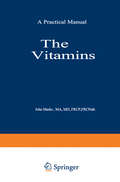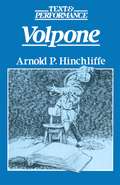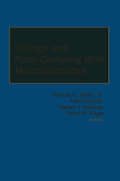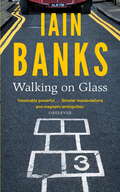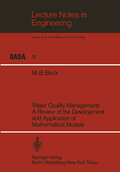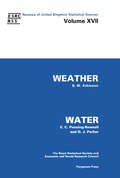- Table View
- List View
Victims of the System
by Robert EliasThis important new book on criminology is a major attempt to evaluate actual victim compensation programs as well as their political and economic contexts, through the eyes of the victims themselves.Elias traces the experiences of violent-crime victims throughout the entire criminal justice process, comparing New York's and New Jersey's victim compensation programs. He shows how programs differ when compensation is viewed essentially as welfare and when it is viewed as a right. The study uses extensive interviews with officials and with violent crime victims.The study indicates victim compensation programs largely fail to achieve their stated goals of improving attitudes toward the criminal-justice system and the government. The programs produce poor attitudes toward government and criminal justice.
Victoria Victorious: (Queen of England Series) (Queen of England Series #3)
by Jean PlaidyIn this unforgettable novel of Queen Victoria, Jean Plaidy re-creates a remarkable life filled with romance, triumph, and tragedy.At birth, Princess Victoria was fourth in line for the throne of England, the often-overlooked daughter spent most of her childhood in genteel poverty, exiled from court because of her mother’s dislike of her uncle, the king. A strong, willful child, Victoria was determined not to be stifled by her powerful uncles or her unpopular, controlling mother. Then at the age of eighteen this almost-forgotten princess became Queen of England. She was finally free of her mother’s iron-hand and her uncles’ manipulations. Her first act as queen was to demand that she be given a room—and a bed—of her own.Victoria’s marriage to Prince Albert was a blissfully happy and produced nine children. Albert was her constant companion and one of her most trusted advisors. Victoria’s grief after Prince Albert’s untimely death was so shattering that for the rest of her life—nearly forty years—she dressed only in black. She survived several assassination attempts, and during her reign England’s empire expanded around the globe until it touched every continent in the world.By the end of her sixty-four-year reign, this "Girl Queen" embodied the glory of the British Empire.
Victorian Divorce (Routledge Library Editions: The Victorian World)
by Allen HorstmanFirst published in 1985. Beginning from the first documented British divorce in 1670, Professor Horstman traces the development of divorce, the different means by which it came about, and the relation of practice to moral attitudes. Many cases are presented in summary form, and give a vivid picture of the patterns of behaviour and the agonies of conscience that accompanied this last resort solution. Written in a vivid style, the book casts an often startling light on the behaviour of our ancestors of little more than a century ago.
Victorian Divorce (Routledge Library Editions: The Victorian World)
by Allen HorstmanFirst published in 1985. Beginning from the first documented British divorce in 1670, Professor Horstman traces the development of divorce, the different means by which it came about, and the relation of practice to moral attitudes. Many cases are presented in summary form, and give a vivid picture of the patterns of behaviour and the agonies of conscience that accompanied this last resort solution. Written in a vivid style, the book casts an often startling light on the behaviour of our ancestors of little more than a century ago.
Violence: A Guide for the Caring Professions (Routledge Library Editions: Domestic Abuse)
by R. Glynn Owens J. Barrie AshcroftFirst published in 1985, this book is designed to help professionals in caring professions understand and deal with the problem of violent behaviour. It explains how theoretical ideas may be translated into practical strategies for the reduction or elimination of violence. It also highlights the issues and problems involved in the evaluation of intervention strategies aimed at dealing with aggressive behaviour. Although the book is based firmly on scientific research, the emphasis is on the practical problem of dealing with violence. As such it will be of interest to those studying social care and social work, but also those whose professional duties bring them face to face with violent behaviour.
Violence: A Guide for the Caring Professions (Routledge Library Editions: Domestic Abuse)
by R. Glynn Owens J. Barrie AshcroftFirst published in 1985, this book is designed to help professionals in caring professions understand and deal with the problem of violent behaviour. It explains how theoretical ideas may be translated into practical strategies for the reduction or elimination of violence. It also highlights the issues and problems involved in the evaluation of intervention strategies aimed at dealing with aggressive behaviour. Although the book is based firmly on scientific research, the emphasis is on the practical problem of dealing with violence. As such it will be of interest to those studying social care and social work, but also those whose professional duties bring them face to face with violent behaviour.
The Viper Squad
by J.B. HadleyMike Campbell, a Special Forces veteran, organizes a squadron of mercenaries to travel to El Salvador and rescue a wealthy American businessman's daughter.
Viral Messenger RNA: Transcription, Processing, Splicing and Molecular Structure (Developments in Molecular Virology #7)
by Yechiel BeckerThe nucleotide sequence of the gene from which messenger RNA mole cules are transcribed is in a form that can be translated by cellular ribosomes into the amino acid sequence of a particular polypeptide, the product of the gene. The discovery of messenger RNA more than twenty years ago led to a series of studies on its organization and function in cells in the presence of infecting viruses. This volume is devoted to current studies in the field of cellular and viral messenger RNA. The studies presented provide an insight into molecular and genetic aspects of messenger RNA. Special attention was paid by the authors to the molecular organization of mRNA species, to the processing of mRNA molecules, and to the different strategies employed by DNA and RNA viruses in the synthesis of their mRNA. The ability of a virus to take over the protein-synthesizing mechanisms of an infected cell depends on its ability to produce mRNA molecules which can affect the host mRNA or utilize cellular components more efficiently. The differences between, and similarities of, the strategies of mRNA synthesis devised by various DNA and RNA viruses are described herein. This book should be of interest to all students of cellular and viral genes and scientists in the field. It is suitable as a textbook for workshops and courses on mRNA. I wish to thank the authors for their fine contributions and for their interest.
Virtue and Medicine: Explorations in the Character of Medicine (Philosophy and Medicine #17)
by Earl E. ShelpThe Viruses: Catalogue, Characterization, and Classification (The Viruses)
by Heinz Fraenkel-ConratDuring the past two decades, virus taxonomy has advanced to the point where most viruses can be classified as belonging to families, genera, or groups of related viruses. Virus classification is primarily based on chem ical and physical similarities, such as the size and shape of the virion, the nature of the genomic nucleic acid, the number and function of com ponent proteins, the presence of lipids and of additional structural fea tures, such as envelopes, and serological interrelationships. The families, genera, or groups of viruses that have been defined on the basis of such criteria by the International Committee on Taxonomy of Viruses (ICTV) will be described in some detail in this catalogue and illustrated by elec tron micrographs. In my present attempt to list most if not all well es tablished and studied viruses in alphabetical order, I have largely confined myself to identifying them only in such taxonomic terms, generally without quoting specific data reported for individual viruses. If the latter data do not at times agree closely with those given for the taxon or group, it is difficult to decide to what extent this is attributable to misclassi fication due to insufficient data and errors in the analytical procedures and descriptions, or to what extent this is an expression of Nature's free dom of choice and abhorrence of restrictive classifications.
Vision in Vertebrates
by M. A. AliWhen Dr. Katherine Tansley's "Vision in Vertebrates" appeared in 1965, it filled a real void that had hitherto existed. It did so by serving at once as a text-book: for an undergraduate course, a general introduction to the subject for post-graduate students embarking on research on some aspect of vision, and the interested non-specialists. Gordon Walls' "The Vertebrate Eye and It. s Adaptive Radiation" and A. Rochon-Duvigneaud's "Les Yeux et la Vision des Vertebres" have served as important sources of information on the subject and continue to do so even though it is 40 years since they appeared. However, they are essentially specialised reference works and are not easily accessible to boot. The genius of Katherine Tansley was to present in a succinct (132 pages) and lucid way a clear and an interesting survey of the matter. Everyone liked it, particularly the students because one could read it quickly and understand it. Thus, when it seemed that a new edition was desirable, especially in view of the enormous strides made and the vast literature that had accumulated in the past 20 years, one of us (MAA) asked Dr. Tansley if she would undertake the task. Since she is in retirement and her health not in a very satisfactory state both she and her son, John Lythgoe (himself a specialist of vision), asked us to take over the task.
The Vitamins: Their Role in Medical Practice
by J. MarksThis book has been designed, as its title implies, as a practical book for medical practitioners, although it should be of interest to medical students and nutritionists. It attempts to provide essential information about this important group of substances rather than be an all embracing monograph on the subject. For this reason biochemical and physiological considera tions have been kept to a minimum, and aspects of animal disorders and animal husbandry have not been considered. The material is often presented in a rather dogmatic fashion and, with rare exceptions, references are not included since this makes reading more difficult. The exceptions, where references are provided, are the therapeutic claims, and the series of recent studies which have indicated that vitamin deficiencies are still widely present among certain groups of the population of many industrially developed countries. To add to this reference list there is a reading list which has been selected to give key books, reviews with extensive bibliography and important articles over the past 10 years. From this reading list it is possible to trace most of the literature on the vitamins since they were first described over half a century ago.
A Voice in the Dark
by Claire LorrimerLaura Howard, a young English nurse on holiday in Italy, helps the Contessa dell’Alba return to her home after an illness. Laura is befriended by the family and feels herself drawn to Domenico, the Contessa’s blind son. To her horror, she suddenly realises that his life is in danger. Enmeshed in a web of intrigue and confusion and unable to find the source of the threats, Laura despairs of her inability to convince the family that they are in mortal danger. Finally aware of her love for Domenico, she tries desperately to uncover the mystery but she soon finds out that her own life is in danger too…
Voltage and Patch Clamping with Microelectrodes
by Thomas G. Smith Harold Lecar Steven J. RedmanEdited and authored by international experts on voltage and patch clamping, this volume is designed to help anyone undertaking experiments requiring the use of these techniques. The only book of its kind to bring together this wealth of information on theory as well as practical techniques, this is a volume that no one involved in voltage and patch clamping can afford to be without.
Walking Machines: An Introduction to Legged Robots (Chapman and Hall Advanced Industrial Technology Series)
by D. J. ToddThe first chapter of this book traces the history of the development of walking machines from the original ideas of man-amplifiers and military rough-ground transport to today's diverse academic and industrial research and development projects. It concludes with a brief account of research on other unusual methods of locomotion. The heart of the book is the next three chapters on the theory and engineering of legged robots. Chapter 2 presents the basics of land loco motion, going on to consider the energetics of legged movement and the description and classification of gaits. Chapter 3, dealing with the mechanics of legged vehicles, goes into leg number and arrangement, and discusses mechanical design and actuation methods. Chapter 4 deals with analysis and control, describing the aims of control theory and the methods of modelling and control which have been used for both highly dynamic robots and multi-legged machines. Having dealt with the theory of control it is necessary to discuss the computing system on which control is to be implemented. This is done in Chapter 5, which covers architectures, sensing, algorithms and pro gramming languages. Chapter 6 brings together the threads of the theory and engineering discussed in earlier chapters and summarizes the current walking machine research projects. Finally, the applications, both actual and potential, of legged locomotion are described. Introduction Research into legged machines is expanding rapidly. There are several reasons why this is happening at this particular time.
Walking On Glass
by Iain BanksHer eyes were black, wide as though with some sustained surprise, the skin from their outer corners to her small ears taut. Her lips were pale, and nearly too full for her small mouth, like something bled but bruised. He had never seen anyone or anything quite so beautiful in his life.'Graham Park is in love. But Sara Fitch is an enigma to him, a creature of almost perverse mystery. Steven Grout is paranoid - and with justice. He knows that They are out to get him. They are. Quiss, insecure in his fabulous if ramshackle castle, is forced to play interminable impossible games. The solution to the oldest of all paradoxical riddles will release him. But he must find an answer before he knows the question.Park, Grout, Quiss - no trio could be further apart. But their separate courses are set for collision.
Watching Dallas: Soap Opera and the Melodramatic Imagination
by Ien AngDallas, one of the great internationally-screened soap operas, offers us first and foremost entertainment. But what is it about Dallas that makes that entertainment so successful, and how exactly is its entertainment constructed?
Watching Dallas: Soap Opera and the Melodramatic Imagination
by Ien AngDallas, one of the great internationally-screened soap operas, offers us first and foremost entertainment. But what is it about Dallas that makes that entertainment so successful, and how exactly is its entertainment constructed?
Water and Ions in Biological Systems
by Alberte Pullman V. Vasilescu L. PackerAs the First International Conference on Water and Ions in Biological Systems (Bucharest, June 25-27, 1980) was appreciated as a success, a second one was organized in the fall of the year 1982 under the sponsorship of the United Nations Educational, Scientific and Cultural Organization (UNESCO), the Romanian Academy of Medical Sciences, the Romanian Biophysical Society (Union of Societies for Medical Sciences in the Socialist Republic of Romania) and in co operation with the International Union for Pure and Applied Bio physics (IUPAB). The responsibility for the scientific program and organization of the Second Conference on Water fell on an International Scientific Committee which included Prof. J. Tigyi (Pees), President of the UNESCO Expert Committee on Biophysics, Prof. K. Wuthrich, Secretary General of IUPAB and Prof. H. Eisenberg, (member of the IUPAB Council) under the guidance of an Executive Board whose members were Prof. J. Jaz (representative of UNESCO), Prof. B. Pullman (Vice President of IUPAB) and Prof. V. Vasilescu (President of the Romanian Biophysical Society). The Meeting was attended by more than 250 specialists including 150 Romanian participants and others from Bulgaria, Czechoslovakia, England, the Federal Republic of Germany, the German Democratic Republic, Greece, Hungary, India, Israel, Italy, Japan, the Netherlands, Nigeria, Poland, Sweden, Switzerland, USSR, USA, Venezuela, Yugoslavia. The proceedings of the Conference took place in the Medical Faculty of Bucharest. The theoretical and practical importance of the Meeting was pointed out by the speakers, among whom were Prof.
Water Quality Management: A Review of the Development and Application of Mathematical Models (Lecture Notes in Engineering #11)
by M.B. BeckDuring 1978-1982 the International Institute for Applied Systems Analysis (IIASA) was responsible for a research project on Environmental Quality Control and Management. The project was begun under the direction of Professor O. F. Vasiliev (from the Institute of Hydrodynamics of the Siberian Branch of the USSR Academy of Sciences) and was subsequently led by myself. This review is very much a re'fiection of that IIASA project. The major themes of the IIASA project were: (i) research into the methodological aspects of modeling river and lake sys tems [some of the principal results of this research appear in M. B. Beck and G. van Straten (eds. ) (1983), Uncertainty and Forecasting of Water Quality (Springer, Berlin (West)), and in K. Fedra (1983), Environmental Modeling Under Uncertainty: Monte Carlo Simulation (IIASA Research Report RR-83-28)]; (ii) case studies in the application of mathematical models to lake eutrophi cation control [results of which are summarized in L. Somlyody, S. Hero dek, and J. Fischer (eds. ) (1983), Eutrophication of Shallow Lakes: Model ing and Management (The Lake Balaton Case Study) (IIASA Collaborative Proceedings CP-83-S3), and in K. Fedra (1983), A Modular Approach to Comprehensive System Simulation: A Case Study of Lakes and Watersheds (in W. K. Lauenroth, G. V. Skogerboe, and M. Flug (eds. ), Analysis of Ecological Systems: State-of-the-Art in Ecological Modelling, pp. 195-204. Elsevier, Amsterdam)]; iv (iii) a policy study of operational water qua,lity management [M. B. Beck (1981), Operational Water Quality Management: Beyond Planning and Design (IIASA Executive Report ER-7)].
Water Waves and Ship Hydrodynamics: An Introduction (Mechanics of Fluids and Transport Processes #5)
by R. Timman A.J. Hermans G.C. HsiaoIn the spring of 1971, Reinier Tirnrnan visited the University of Delaware during which time he gave a series of lectures on water waves from which these notes grew. Those of us privi leged to be present during that time will never forget the experience. Rein Tirnrnan is not easily forgotten. His seemingly inexhaustible energy completely overwhelmed us. Who could forget the numbing effect of a succession of long wine filled evenings of lively conversation on literature, politics, education, you name it, followed early the next day by the appearance of the apparently totally refreshed red haired giant eager to discuss our mathematical problems with keen insight en remarkable understanding, ready to lecture on fluid mechanics or optimal control theory or a host of other subjects and ready to work into the evening until the cycle repeated. He thought faster, he knew more, he drank more and he slept less than any of us mortals and he literally wore us out. What a rare privilege indeed to have participated in this intellectual orgy. Tirnrnan's lively interest in almost every thing coupled with his buoyant enthusiasm and infectious op timism epitomized his approach to life. No delicate nibbling at the fringes, he wanted every morsel of every course. In these times of narrow specialization truly renaissance figures are, if not extinct, at least a highly endangered species. But Tirnrnan was one of that rare breed.
Weather & Water (Reviews of UK Statistical Sources (RUKSS))
by B.W. Atkinson E.C. Penning-Rowsell D.J. ParkerThis volume reviews statistical information held in a variety of sources in the UK dealing with weather and water. In view of the influence of weather and water supplies on industry and environmental quality, this text will be of particular interest to researchers in these fields.
Weed Physiology: Volume I: Reproduction and Ecophysiology
by Stephen O. DukeWeeds are plants existing at places and/or times at which they are considered undesirable by man. Thys, man‘s primary interest in weeds is in dinging methods for eliminating their presences. Understanding the physiology of weeds and how it differs from that of crop plants is becoming increasingly important in discovering new chemical, genetic, and cultural methods of controlling weeds. The two volumes of this book will aim to discuss the following; the physiology of weed production the ecophysiology of weeds, the mechanisms of herbicide action, and the mechanisms of herbicide resistance and tolerance.










